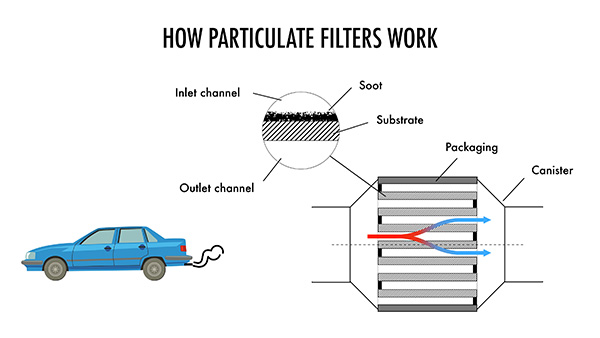
Diesel engines offer impressive durability and fuel efficiency, making them a popular choice for trucks, commercial vehicles, and long-haul driving. But with that efficiency comes responsibilities—keeping the Diesel Particulate Filter (DPF) clean and functioning properly is one of them. The DPF plays a crucial role in reducing harmful emissions by trapping soot and particulate matter, but over time, it can become clogged if not maintained. A blocked DPF can cause reduced fuel economy, sluggish performance, and even costly engine damage. So, how can you keep your DPF in top condition and avoid expensive repairs?
What is a DPF
The Diesel Particulate Filter (DPF) is an emissions control device designed to capture and store soot and particulate matter from diesel exhaust. This prevents harmful pollutants from being released into the air, helping vehicles meet strict emissions standards. However, because the DPF collects soot over time, it needs to be cleaned regularly to prevent clogging.
A clogged DPF can cause several issues, including reduced fuel efficiency, decreased engine power, and increased emissions. In severe cases, a completely blocked DPF can trigger limp mode, limiting your vehicle’s performance and making driving difficult.
How Does a DPF Clean Itself
Most modern diesel vehicles are equipped with regeneration systems, which help clean the DPF automatically. There are three types of regeneration:
- Passive Regeneration – Happens naturally during highway driving when the exhaust temperature is high enough to burn off soot.
- Active Regeneration – Occurs when the engine injects extra fuel into the exhaust system to increase the temperature and burn off built-up soot.
- Manual Regeneration – Requires the driver or a technician to initiate the cleaning process when the DPF becomes too clogged for automatic regeneration to work.
While these systems help keep the DPF clean, they are not foolproof. If you frequently drive short distances, idle for long periods, or don’t allow your vehicle to reach high temperatures, your DPF may not regenerate properly, leading to blockages.
Signs That Your DPF Needs Cleaning
A well-maintained DPF should last for thousands of miles, but if regeneration doesn’t occur properly, you may start noticing warning signs. Common indicators that your DPF needs cleaning include:
- A DPF warning light on your dashboard – This is the most obvious sign that the filter is clogged.
- Reduced engine performance – A blocked DPF can restrict airflow, leading to sluggish acceleration and poor fuel efficiency.
- Increased fuel consumption – If your engine is working harder to push exhaust through a clogged filter, fuel economy will suffer.
- Frequent limp mode activation – If the DPF becomes severely blocked, your vehicle may enter limp mode, limiting power until the issue is resolved.
Ignoring these warning signs can result in costly repairs or even permanent damage to your engine. Addressing DPF issues early can help you avoid downtime, improve fuel efficiency, and keep your vehicle running at its best. Why wait until it turns into a bigger problem?
How to Keep Your DPF in Good Condition
Proper maintenance can extend the life of your DPF and prevent costly replacements. Here are some tips to ensure your filter stays clean and functional:
Drive on the highway regularly
Short trips and stop-and-go traffic don’t allow the DPF to reach the necessary temperature for regeneration. Taking your vehicle on the highway for at least 20–30 minutes at higher speeds helps burn off accumulated soot.
Use high-quality diesel fuel
Low-quality fuel can produce more soot, clogging the filter faster. Using premium diesel or fuel additives can help reduce buildup.
Avoid excessive idling
Idling for long periods prevents the exhaust from reaching the temperatures needed for regeneration. Turn off your engine when parked for extended periods.
Get regular DPF inspections
If your DPF warning light comes on frequently, a professional inspection can determine whether the filter needs cleaning or if there’s an underlying issue causing excessive soot buildup.
When to Get Professional DPF Cleaning
If your DPF becomes too clogged for automatic regeneration to clean it, a professional cleaning may be necessary. At this point, there are two main options:
- Forced Regeneration – A technician uses a diagnostic tool to manually trigger the regeneration process, burning off excess soot.
- DPF Removal and Cleaning – In cases of severe blockage, the DPF is removed and cleaned using specialized equipment to restore its function.
Some drivers attempt DIY cleaning methods, but improper cleaning can damage the filter, leading to costly replacements. A professional service ensures that the DPF is cleaned safely and effectively.
A clogged DPF can lead to major engine issues. Let KAMS Auto Service Center inspect and clean your filter for peak diesel performance. Call now to schedule your service!